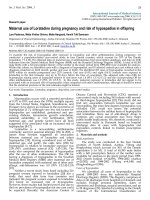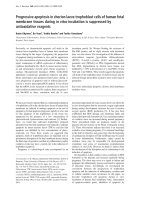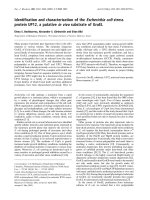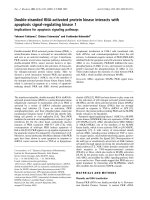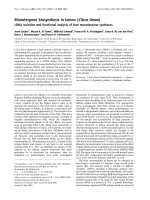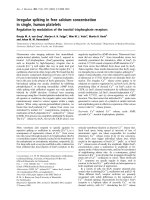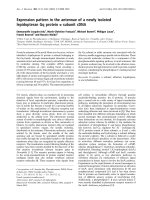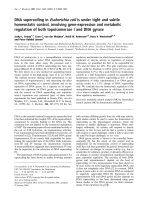Báo cáo y học: "Maternal Smoking in Pregnancy: Do the Effects on Innate (Toll-Like Receptor) Function Have Implications for Subsequent Allergic Disease" pps
Bạn đang xem bản rút gọn của tài liệu. Xem và tải ngay bản đầy đủ của tài liệu tại đây (314.2 KB, 9 trang )
ORIGINAL ARTICLE
Maternal Smoking in Pregnancy: Do the Effects on Innate
(Toll-Like Receptor) Function Have Implications for
Subsequent Allergic Disease?
Susan L. Prescott, MBBS, BMedSci, PhD, FRACP and Paul S. Noakes, BSc(Hons), PhD
Subtle increases in immaturity of immune function in early infancy have been implicated in the rising susceptibility to allergic
disease, particularly relative impairment of type 1 interferon (IFN)-c responses in the neonatal period. Although genetic
predisposition is a clear risk factor, the escalating rates of allergic disease in infancy suggest that environmental factors are also
implicated. We previously showed that maternal smoking in pregnancy may impair neonatal IFN-c responses. Our more recent
studies now indicate that this common avoidable toxic exposure is also associated with attenuation of innate immune function, with
attenuated Toll-like receptor (TLR)-mediated microbial responses (including TLR-2, -3, -4, and -9 responses). Most notably, the effects
were more marked if the mothers were also allergic. In this review, we discuss the significance of these observations in the context of
the emerging hypothesis that variations in TLR function in early life may be implicated in allergic propensity. There is now growing
evidence that many of the key pathways involved in subsequent T-cell programming and regulation (namely, antigen-presenting
cells and regulatory T cells) rely heavily on microbe-driven TLR activation for maturation and function. Factors that influence the
function and activity of these innate pathways in early life may contribute to the increasing predisposition for allergic disease.
Although ‘‘cleaner’’ environments have been implicated, here we explore the possibility that other common environmental
exposures (such as maternal smoking) could also play a role.
Key words: allergic disease, cord blood, cotinine, cytokines, innate immunity, pregnancy, smoking, Toll-like receptors
A
striking increase in immune-mediated diseases has
been one of the most concerning changes in disease
prevalence during the late twentieth century. Although the
reasons for this are not clear, environmental changes are
clearly implicated. This change has involved major
increases in apparently diverse disease processes, including
a spectrum of allergic diseases and autoimmune diseases.
1
This increase in immune dysregulation, often very early in
life, has led to intense interest in factors that influence to
early immune maturation.
Although microbial factors are known to enhance
immune maturation, factors that may inhibit early
immune maturation are less well documented. Here we
explore the potential role of maternal smoking in
pregnancy on infant immune development. Specifically,
we examine the novel hypothesis that maternal smoking
causes a relative impairment of innate defense through
effects on the developing immune system in pregnancy.
We speculate that these effects may not only contribute to
the increased risk of infection
2
but may also be implicated
in the increased rates of other forms of chronic
inflammatory respiratory disease seen in these children,
3
including asthma and recurrent wheezing.
4,5
Whereas
there have been extensive studies of the effects of cigarette
smoking on neonatal lung mechanics,
6,7
there is only
relatively limited information about the effects on devel-
oping immune responses.
The prevalence of smoking in women of child-bearing
age generally ranges between 17 and 35% around the
world. Although the rates of smoking in pregnancy have
generally declined over the last 10 years, a significant
proportion (10–20%) of women continue to smoke in
Susan L. Prescott and Paul S. Noakes: School of Paediatrics and Child
Health, University of Western Australia, Princess Margaret Hospital for
Children, Perth, Western Australia.
Prof. Prescott is funded by the National Health and Medical Council (of
Australia).
Correspondence to: Associate Professor Susan L. Prescott, School of
Paediatrics and Child Health, University of Western Australia, Princess
Margaret Hospital for Children, GPO Box D184, Perth, Western
Australia 6840.
DOI 10.2310/7480.2006.00017
10 Allergy, Asthma, and Clinical Immunology, Vol 3, No 1 (Spring), 2007: pp 10–18
pregnancy, and this is heavily influenced by maternal age,
ethnicity, education, and socioeconomic level.
8–11
At this stage, it is unclear if the decline in maternal
smoking is linked to the declining rates of asthma in some
developed countries during the same period.
12
Although it is
unlikely that maternal smoking is the primary causal factor
in the changing prevalence of asthma, we are proposing that
it is an important contributing factor, with significant
potential to interact with other genetic factors and environ-
mental risk factors to modify disease propensity.
Preliminary Evidence that Maternal Smoking Has
Immunologic Effects on the Developing Fetus
There has been growing evidence that subtle increases in
immaturity of immune function, particularly Th1 interferon
(IFN)-c responses, during early infancy may be associated
with allergy risk and subsequent disease.
13–16
We previously
noted that maternal smoking in pregnancy is associated with
lower Th1 responses to polyclonal stimulation,
17
although
this study measured messenger ribonucleic acid (mRNA)
expression rather than protein levels. Others have also noted
differences in the immune function of neonates whose
mothers smoked in pregnancy. Early studies noted that
parental smoking is associated with higher cord blood
immunoglobulin E (IgE) levels,
18
and, subsequently,
Devereux and colleagues observed that maternal smoking
is associated with stronger neonatal allergen-specific
responses,
19
providing preliminary evidence that maternal
smoking has effects on fetal cellular immune function. In our
more recent studies, we measured the specific effects of
smoking on Toll-like receptor (TLR) innate defence path-
ways (below), which could both explain an increased
susceptibility to infection and have implications for
subsequent allergen-specific immune development.
Role of Innate Immunity in Subsequent Immune
Development
Innate immunity plays a key role in immune defence in the
neonatal period before the development of environmen-
tally driven adaptive immune responses. This aspect of the
immune system is activated through highly conserved
receptors, including the TLR family, that recognize a broad
range of microbial agents.
20
These receptors are found on
many cells involved in immediate host defence, such as
neutrophils, natural killer cells, and antigen-presenting
cells (APCs). Differential expression of TLR on these cell
types (as summarized in Figure 1) allows specialized
responses to different microbial components. Activation of
APCs through the TLR also has implications for adaptive
immune function as these cells play a critical role in
programming effector responses. Once activated via these
pathways, dendritic cells (DCs) and other APCs show
Figure 1. Cell surface expression of
Toll-like receptors and their ligands.
Prescott and Noakes, Implications of Maternal Smoking for Subsequent Allergic Disease 11
enhanced expression of costimulatory molecules and
cytokines (including interleukin [IL]-12), which favour
Th1 immune differentiation. TLRs (TLR-4, -5, -7, and -8)
have also more recently been identified on CD4
+
CD25
+
T
regulatory cells
21
that play a critical role in controlling
immune responses.
22
Thus, it has been proposed that TLR-
mediated activation of both APCs and regulatory T cells
may play an important role in reducing the risk of Th2-
mediated allergic responses.
22,23
This is obviously of most
relevance in early life when programming of immunologic
function is initiated.
We speculate that TLR function matures in the
postnatal period and that children who develop allergic
disease have differences in these development patterns as a
result of genetic predisposition and/or environmental
influences. This hypothesis is based on preliminary
evidence that TLR function is developmentally regulated,
with differences between infants and adults,
24,25
and that
genetic and environmental factors can modify TLR
function in early life, as discussed below.
Emerging Interest in the Role of Early TLR Function
in the Risk of Allergic Disease
At this stage, there is only preliminary evidence that
children at high risk of allergic disease have altered TLR
function. First, in a small study, newborns of allergic
women (N 5 9) had significantly lower in vitro responses
after TLR-2 ligation (with peptidoglycan) compared with
those of nonallergic women (p 5 .03).
26
In another larger
study (N 5 185), maternal allergy was associated with
significantly lower levels of TLR-2, TLR-4, and CD14
mRNA in cord blood samples.
27
Neonates at ‘‘high risk’’
of allergy have also been noted to have altered genera-
tion of putative T regulatory cell populations after
lipopolysaccharide (LPS) stimulation, presumably through
TLR-4 pathways.
28
At this stage, the significance of these
findings is unclear. Maternal allergy appears to confer
‘‘allergy risk’’ not only by genetic inheritance but also by
direct immune interactions in pregnancy, as we recently
reported.
29
Evidence that Environmental Factors that Modify
Early TLR-Mediated Immune Activation Can Alter
Allergy Risk
There is good evidence in animal models that TLR
activation using microbial products can modify immune
development and the risk of allergic sensitization, although
this has not been examined directly in humans. Blumer
and colleaguers recently demonstrated that TLR-4 activa-
tion (giving endotoxin) in pregnancy enhanced neonatal
Th1 IFN-c responses and inhibited (ovalbumin) allergen
sensitization in the offspring.
30
Tulic and colleagues
showed similar effects of the same TLR-4 ligand in the
postnatal period, but, notably, the inhibition of allergic
responses was seen only when endotoxin was given before
responses were established.
31
In humans, exposure to
farming animals (and presumably higher endotoxin levels)
has been associated with both increased gene expression
(of TLR-2: odds ratio 1.16, 95% confidence interval [CI]
1.07–1.26; of TLR-4: odds ratio 1.12, 95% CI 1.04–1.2) and
the risk of allergic sensitization (adjusted odds ratio 0.58,
95% CI 0.39–0.86).
32
Intervention studies also suggest that
administration of bacterial products to children may have
clinical
33,34
and immune
35
effects. Although it has been
inferred that these variations in microbial exposure may be
responsible for differences in innate (and subsequent
cognate) immune function, this has not been documented
directly.
There is also evidence that genetically conferred
variations in TLR function may be implicated in allergic
disease. TLR-2 genetic polymorphisms were shown to have
a protective effect on asthma.
36
Notably, the ‘‘protective’’
effectwasseenonlywhenchildrenwereraisedin
environments with ‘‘high’’ microbial burden, illustrating
the interactive effects of genetic and environmental factors
on these pathways. Polymorphisms in the TLR4 gene have
been associated with atopic asthma in some
37
but not all
studies,
38,39
raising questions over the functional signifi-
cance of these polymorphisms. These conflicting results
could also suggest complex gene and environment
interactions and that the same genetic background might
result in the expression of different phenotypes in different
environments. This requires large-scale population studies
involving many thousands of children, which are becom-
ing more realistic as multicentre collaborations develop
further in this field.
Together, these findings suggest that alterations in TLR
function, either as a result of differences in early environ-
mental exposures or functional genetic polymorphisms, have
an effect on subsequent development of adaptive immune
function. Here we explore the effects of maternal smoking on
TLR function and these interactions.
Effects of Maternal Smoking in Innate (TLR)
Immune Development
The increased rate of respiratory disease
40
and infection
2
in
infants of smoking mothers is well recognized. These
12 Allergy, Asthma, and Clinical Immunology, Volume 3, Number 1, 2007
effects may be mediated by a number of pathways,
including in utero effects and ongoing toxic effects in the
postnatal period. Adverse effects on airway development
are well documented,
41–45
and there is also preliminary
evidence that maternal smoking may also have effects on
immune development.
17,19
We now speculate that the
toxic effects of maternal smoking may be having effects on
the development and function of innate responses, and
this may be implicated in the susceptibility to both
infection and asthma in exposed infants.
We recently addressed this hypothesis in a prospective
cohort study that compared innate immune function in the
neonates of women who smoked in pregnancy (n 5 58) with
that of the neonates of nonsmokers (n 5 59). Women were
recruited early in pregnancy when detailed clinical and
smoking histories were collected. Cotinine levels were
measured in maternal and cord blood plasma to confirm
differences in cigarette smoke exposure. This demonstrated
significantly higher levels in the smoking group (p , .001),
with largely undetectable levels in the nonsmokers, and
significant correlations between cotinine levels and self-
reported smoke exposure. Cord blood mononuclear cells
were isolated to assess the effects of maternal smoking in
pregnancy on TLR function, using optimal doses of specific
microbial ligands for TLR-2 ligand (pansorbin
[Staphylococcus aureus] 0.1%), TLR-3 ligand (polyinosinic-
polycytidylic acid:cytosine-phosphate-guanine [CpG] 30 mg/
mL), TLR-4 ligand (LPS 10 ng/mL), and TLR-9 ligand (CpG
1.66 mg/mL). Functional responses to these ligands were
assessed by cytokine production (tumor necrosis factor
[TNF]-a,IL-10,andIL-6,principallyderivedfromAPCsin
this culture system) after 48 hours, as previously described.
46
We observed that the infants of smoking mothers showed
significant attenuation of a number of aspects of innate TLR-
mediated responses compared with the infants of non-
smokers.
47
This included significantly lower cytokine
responses following TLR-2 (TNF-a, p 5 .004; IL-6, p 5
.045; IL-10, p 5 .014), TLR-3 (TNF-a, p 5 .044), TLR-4
(TNF-a, p 5 .034), and TLR-9 (IL-6, p 5 .046) activation.
There were also consistent negative correlations between
cotinine levels and cytokine (IL-6, IL-10, and TNF-a)
responses to these TLRs. Although women who smoked
were also more likely to have lower educational levels and
consume other recreational drugs during pregnancy, the
relationships between maternal smoking status and immune
function remained evident after these effects were accounted
for in multiple regression modeling. These observations
appear to confirm our hypothesis that maternal smoking
may attenuate aspects of innate immune function in the
neonatal period; however, it remains possible that other
maternal factors that could not be measured could
contribute the differences between these populations.
Possible Pathways of Influence: Immune Effects of
Oxidative Stress?
Cigarette smoke is a major source of free radicals and
oxidative stress.
48
Recent studies have identified smoking-
induced disruption of oxygen-related responses that are
known to play a key role in placental cytotrophoblast
proliferation and differentiation during critical early stages
of development.
49
Most notably, effects were also seen
when women were passively exposed to tobacco smoke.
49
Foreseeably, these disruptions in antioxidant systems could
lead to further disruptions of local immune function in the
placenta and in the fetus. Oxidative stress plays a major
role in inflammation. Macrophages infiltrate inflamed
tissue and release reactive oxygen species and reactive
nitrogen species and, in doing so, become depleted of
antioxidants, as reflected by their reduced glutathione
status.
50
It has been demonstrated that a change in the
‘‘redox’’ status (reduced glutathione) of APCs (macro-
phages) promotes CD4 T-cell Th2 differentiation
50
and the
production of IL-4 and IL-5, which contribute allergic
inflammation. Specifically, oxidative stress promotes pro-
Th2 signaling by APCs by reducing IL-12 production in
mice
50
and humans (which can be reversed by antiox-
idants
51
). Thus, the effects of modifying oxidative function
provide a plausible pathway for smoking in modifying
developing immune responses.
Molecular Targets: Effects on Transcription Factors?
The production of inflammatory cytokines is mediated
through transcription factors such as nuclear factor (NF)-
kB and activator protein 1.
52,53
In vitro studies demon-
strate that cigarette smoke extracts reduce proinflamma-
tory LPS-induced TLR-4 signaling by inhibiting
transcription factors.
54,55
More recently, Valacchi and
colleagues demonstrated that a major constituent of
cigarette smoke (acrolein) suppresses epithelial production
of inflammatory chemokine IL-8 through direct inhibition
of NF-kB.
56
Based on these findings, we speculate that
smoking may affect TLR signaling via nuclear effects on
transcription factors (Figure 2). There may be preliminary
evidence that this occurs following direct mucosal
exposure,
54,56
and it is possible that the systemic in utero
effects observed in our study could be mediated through a
similar pathway. This could be assessed in future studies
Prescott and Noakes, Implications of Maternal Smoking for Subsequent Allergic Disease 13
examining the effects of maternal smoking on neonatal
mRNA expression following TLR ligation.
Differential Effects of Maternal Smoking in Infants
at High Risk of Allergy?
Our study (above) included approximately an equal
number of allergic (n 5 62) and nonallergic women (n
5 60), who were distributed equally among the smoking
group (n 5 32 allergic) and the nonsmokers (n 5 30
allergic). Allergic status was confirmed by allergen
skinprick testing (SPT) to common allergens (with at
least one positive SPT to dust mite, cats, dogs, grass
pollens, moulds, or cockroaches).
First, we examined the effects of maternal allergy on
TLR-mediated responses (as the proportion of smokers in
Figure 2. Potential mechanisms of action: possible effects of smoking in common transduction pathways. Reproduced with permission from Hole
J. The innate immune mechanisms of prostate epithelium during bacterial infection [thesis]. Perth: Department of Microbiology, University of
Western Australia; 2003.
14 Allergy, Asthma, and Clinical Immunology, Volume 3, Number 1, 2007
these groups was the same). Although other studies
(discussed above) have noted that infants at high risk of
allergic disease (based on maternal allergy) have reduced
TLR expression
27
and function,
26
we did not see any
consistent effects in this study. The only difference that
approached statistical significance was a trend for lower
IL-10 responses following TLR-2 ligation (with pansorbin)
(p 5 .06) in the allergic group (n 5 62).
Second, we determined if infants at high risk of allergy
(maternal allergy) are also more susceptible to the effects
of maternal smoking. Whereas TNF-a responses (to TLR-
2, -3, and -4 activation) were significantly attenuated in
smokers, this was seen only in infants of atopic mothers
(for TLR-2, p 5 .014; TLR-3, p 5 .048; and TLR-4, p 5
.014), with no significant effects of smoking in the
nonatopic group. Although there was a trend in the
nonatopic group for smokers to have impaired TNF-a
responses to TLR-2, this did not reach statistical
significance (p 5 .094). These findings indicate that the
effects of smoking on TNF-a responses are significantly
enhanced by maternal allergy. Thus, both maternal
allergy
27
and function
26
and maternal smoking
47
may
have effects on aspects of neonatal immune function
(although in our study, smoking had a more significant
effects). Although some of these effects are independent,
our data also suggest some interactive potentiating effects.
Specifically, we have shown that maternal atopic status
selectively amplifies the effect of smoking on some
activation pathways.
Implications of Our Findings for the Risk of
Subsequent Development of Allergic Disease?
Whereas maternal smoking in pregnancy has been
associated with an increased risk of asthma and reduced
lung function is well described,
4,5
the relationship between
subsequent atopic risk has been more controversial. A
number of studies have linked parental smoking with
markers of atopy in children,
57,58
including serum IgE
levels,
7,59–62
eosinophilia,
7,63
and positive SPTs.
64
Despite
this, a systematic review by Strachan and Cook in 1998 did
not find any conclusive association.
65
However, this did
not include the results of a more recent study by Kulig and
colleagues, which reported a significantly higher risk of
sensitization to food allergens (odds ratio 2.3, 95% CI 1.1–
4.6) in children exposed to maternal smoking compared
with unexposed children.
66
It is now well recognized that
genetic polymorphisms in antioxidant pathways may
contribute to differences in susceptibility to the effects of
cigarette smoke,
67
and genetic differences could account
for some of the differences between studies.
Our recent findings could provide an important
pathway through which maternal smoking could potenti-
ate the development of allergy. We have shown that
smoking has direct effects on neonatal APC function, as
detected by impaired innate responses to microbial
stimulation. It could be argued that persistent immaturity
of APC responses to bacteria could interfere with microbe-
driven Th1 maturation (which is mediated via TLR
pathways). Other studies have shown an in vitro
immunosuppressive effect of nicotine on APC (DC)
function, including as antigen-capturing, cytokine produc-
tion (particularly IL-12 production), and eventually T-cell
priming and polarization.
68
This has implications for
allergic risk as impaired Th1 function in the perinatal
period has been linked to allergic risk in many studies.
13–16
TLR activation is also important for activation of T
regulatory cells, which are also important for suppression
of allergic Th2 responses. Together, these effects could
contribute to increased allergic risk.
However, at this stage, it is not clear how long these
effects on APC function might persist in the postnatal
period. It could also be argued that a resultant increased
susceptibility to infection could provide a strong source of
APC-driven Th1 immune maturation. Thus, although it is
possible that the effects of maternal smoking on early TLR
function may contribute to the well-documented increase
in early postnatal susceptibility to respiratory tract
infections in exposure infants,
2
further studies are needed
to examine the longitudinal effects on the development of
allergen-specific memory.
Concluding Comments
In summary, our findings show that in addition to the
effects on developing airways, maternal smoking in
pregnancy also has significant immunologic effects that
could contribute to increased risk of respiratory infections
and asthma. These effects appear to be mediated through
effects on TLR-mediated innate response pathways, which
also promote regulatory pathways in the inhibition of
allergic immune responses. This highlights the fact that
other environmental interactions are highly relevant to the
‘‘hygiene hypothesis.’’ Specifically, although the level of
early microbial exposure is the strongest determinant of
TLR-mediated immune maturation, our findings demon-
strate that other environmental exposures (such as
maternal smoking) may also have an influence. There is
no doubt that smoking should be avoided in all
Prescott and Noakes, Implications of Maternal Smoking for Subsequent Allergic Disease 15
pregnancies because of the many adverse effects, and our
studies suggest that the adverse effects on fetal immune
development could be even greater in atopic women.
Acknowledgements
We wish to acknowledge the staff and patients who assisted
in our studies. We are particularly grateful to the
obstetricians and midwives at King Edward Memorial
Hospital and St John of God Hospital, Subiaco, Western
Australia. Finally, we wish to acknowledge Ms. Elaine
Pascoe for statistical advice.
References
1. Bach JF. The effect of infections on susceptibility to autoimmune
and allergic diseases. N Engl J Med 2002;347:911–20.
2. Jedrychowski W, Flak E. Maternal smoking during pregnancy and
postnatal exposure to environmental tobacco smoke as predis-
position factors to acute respiratory infections. Environ Health
Perspect 1997;105:302–6.
3. Chan-Yeung M, Dimich-Ward H. Respiratory health effects of
exposure to environmental tobacco smoke. Respirology 2003;8:
131–9.
4. Gilliland FD, Berhane K, Li YF, et al. Effects of early onset asthma
and in utero exposure to maternal smoking on childhood lung
function. Am J Respir Crit Care Med 2003;167:917–24.
5. Gilliland FD, Berhane K, McConnell R, et al. Maternal smoking
during pregnancy, environmental tobacco smoke exposure and
childhood lung function. Thorax 2000;55:271–6.
6. Le Souef PN. Pediatric origins of adult lung diseases. 4. Tobacco
related lung diseases begin in childhood. Thorax 2000;55:
1063.
7. Ronchetti R, Macri F, Ciofetta G, et al. Increased serum IgE
and increased prevalence of eosinophilia in 9-year-old children
of smoking parents. J Allergy Clin Immunol 1990;86(3 Pt 1):400–
7.
8. Ananth CV, Kirby RS, Kinzler WL. Divergent trends in maternal
cigarette smoking during pregnancy: United States 1990-99.
Paediatr Perinat Epidemiol 2005;19:19–26.
9. Colman GJ, Joyce T. Trends in smoking before, during, and after
pregnancy in ten states. Am J Prev Med 2003;24:29–35.
10. Mohsin M, Bauman AE. Socio-demographic factors associated
with smoking and smoking cessation among 426,344 pregnant
women in New South Wales, Australia. BMC Public Health 2005;5:
138.
11. Shaw M, Lawlor DA, Najman JM. Teenage children of teenage
mothers: psychological, behavioural and health outcomes from an
Australian prospective longitudinal study. Soc Sci Med 2006;62:
2526–39.
12. Robertson CF, Roberts MF, Kappers JH. Asthma prevalence in
Melbourne schoolchildren: have we reached the peak? Med J Aust
2004;180:273–6.
13. Kondo N, Kobayashi Y, Shinoda S, et al. Reduced interferon
gamma production by antigen-stimulated cord blood mono-
nuclear cells is a risk factor of allergic disorders—6-year follow- up
study. Clin Exp Allergy 1998;28:1340–4.
14. Tang MLK, Kemp AS, Thorburn J, Hill D. Reduced interferon
gamma secretion in neonates and subsequent atopy. Lancet 1994;
344:983–5.
15. Rinas U, Horneff G, Wahn V. Interferon gamma production by
cord blood mononuclear cells is reduced in newborns with a family
history of atopic disease and is independent from cord blood IgE
levels. Pediatr Allergy Immunol 1993;4:60–4.
16. Prescott SL, Macaubas C, Smallacombe T, et al. Reciprocal age-
related patterns of allergen-specific T-cell immunity in normal vs.
atopic infants. Clin Exp Allergy 1998;28 Suppl 5:39–44; discussion
50–1.
17. Noakes PS, Holt PG, Prescott SL. Maternal smoking in pregnancy
alters neonatal cytokine responses. Allergy 2003;58:1053–8.
18. Magnusson C. Maternal smoking influences cord serum IgE and
IgD levels and increases the risk for subsequent infant allergy. J
Allergy Clin Immunol 1986;78:898–904.
19. Devereux G, Barker RN, Seaton A. Antenatal determinants of
neonatal immune responses to allergens. Clin Exp Allergy 2002;32:
43–50.
20. Aderem A, Ulevitch RJ. Toll-like receptors in the induction of the
innate immune response. Nature 2000;406:782–7.
21. Caramalho I, Lopes-Carvalho T, Ostler D, et al. Regulatory T cells
selectively express toll-like receptors and are activated by
lipopolysaccharide. J Exp Med 2003;197:403–11.
22. Wills-Karp M, Santeliz J, Karp CL. The germless theory of allergic
disease: revisiting the hygiene hypothesis. Nat Rev Immunol 2001;
1:69–75.
23. Holt P, Macaubas C, Prescott S, Sly P. Microbial stimulation as
an aetiologic factor in atopic disease. Allergy 1999;54 Suppl 49:12–
6.
24. Levy O, Zarember KA, Roy RM, et al. Selective impairment of
TLR-mediated innate immunity in human newborns: neonatal
blood plasma reduces monocyte TNF-alpha induction by bacterial
lipopeptides, lipopolysaccharide, and imiquimod, but preserves the
response to R-848. J Immunol 2004;173:4627–34.
25. De Wit D, Tonon S, Olislagers V, et al. Impaired responses to toll-
like receptor 4 and toll-like receptor 3 ligands in human cord
blood. J Autoimmun 2003;21:277–81.
26. Amoudruz P, Holmlund U, Malmstrom V, et al. Neonatal immune
responses to microbial stimuli: is there an influence of maternal
allergy? J Allergy Clin Immunol 2005;115:1304–10.
27. Krauss-Etschmann S, Hartl D, Heinrich J, et al. Association
between levels of Toll-like receptors 2 and 4 and CD14 mRNA and
allergy in pregnant women and their offspring. Clin Immunol
2006;118:292–9.
28. Haddeland U, Karstensen AB, Farkas L, et al. Putative regulatory T
cells are impaired in cord blood from neonates with hereditary
allergy risk. Pediatr Allergy Immunol 2005;16:104–12.
29. Prescott SL, Taylor A, Roper J, et al. Maternal reactivity to
fetal alloantigens is related to newborn immune responses
and subsequent allergic disease. Clin Exp Allergy 2005;35:417–
25.
30. Blumer N, Herz U, Wegmann M, Renz H. Prenatal lipopolysac-
charide-exposure prevents allergic sensitisation and airway inflam-
mation, but not airway responsiveness in a murine model of
experimental asthma. Clin Exp Allergy 2005;35:397–402.
16 Allergy, Asthma, and Clinical Immunology, Volume 3, Number 1, 2007
31. Tulic MK, Wale JL, Holt PG, Sly PD. Modification of the
inflammatory response to allergen challenge after exposure to
bacterial lipopolysaccharide. Am J Respir Cell Mol Biol 2000;22:
604–12.
32. Ege MJ, Bieli C, Frei R, et al. Prenatal farm exposure is related to
the expression of receptors of the innate immunity and to atopic
sensitization in school-age children. J Allergy Clin Immunol 2006;
117:817–23.
33. Arkwright PD, David TJ. Intradermal administration of a killed
Mycobacterium vaccae suspension (SRL 172) is associated with
improvement in atopic dermatitis in children with moderate-to-
severe disease. J Allergy Clin Immunol 2001;107:531–4.
34. Weston S, Halbert A, Richmond P, Prescott SL. Effects of
probiotics on atopic dermatitis: a randomised controlled trial.
Arch Dis Child 2005;90:892–7.
35. Prescott SL, Dunstan JA, Hale J, et al. Clinical effects of probiotics
are associated with increased interferon-gamma responses in very
young children with atopic dermatitis. Clin Exp Allergy 2005;35:
1557–64.
36. Eder W, Klimecki W, Yu L, et al. Toll-like receptor 2 as a major
gene for asthma in children of European farmers. J Allergy Clin
Immunol 2004;113:482–8.
37. Fageras Bottcher M, Hmani-Aifa M, Lindstrom A, et al. A TLR4
polymorphism is associated with asthma and reduced lipopoly-
saccharide-induced interleukin-12(p70) responses in Swedish
children. J Allergy Clin Immunol 2004;114:561–7.
38. Yang IA, Barton SJ, Rorke S, et al. Toll-like receptor 4
polymorphism and severity of atopy in asthmatics. Genes
Immun 2004;5:41–5.
39. Noguchi E, Nishimura F, Fukai H, et al. An association study of
asthma and total serum immunoglobin E levels for Toll-like
receptor polymorphisms in a Japanese population. Clin Exp
Allergy 2004;34:177–83.
40. DiFranza JR, Aligne CA, Weitzman M. Prenatal and postnatal
environmental tobacco smoke exposure and children’s health.
Pediatrics 2004;113(4 Suppl):1007–15.
41. Brown RW, Hanrahan JP, Castille RG, Tager IB. Effect of maternal
smoking during pregnancy on passive respiratory mechanics in
early infancy. Pediatr Pulmonol 1995;19:23–8.
42. Hanrahan JP, Tager IB, Segal MR, et al. The effect of maternal
smoking during pregnancy on early infant lung function. Am Rev
Respir Dis 1992;145:1129–35.
43. Hoo A, Matthias H, Dezateux C, et al. Respiratory function among
preterm infants whose mothers smoked during pregnancy. Am J
Respir Crit Care Med 1998;158:700–5.
44. Lodrup Carlsen KC, Jaakkola JJ, Nafstad P, Carlsen KH. In utero
exposure to cigarette smoking influences lung function at birth.
Eur Respir J 1997;10:1774–9.
45. Stick SM, Burton PR, Gurrin L, et al. Effects of maternal smoking
during pregnancy and a family history of asthma on respiratory
function in newborn infants. Lancet 1996;348:1060–4.
46. Dunstan J, Mori TA, Barden A, et al. Fish oil supplementation
in pregnancy modifies neonatal allergen-specific immune
responses and clinical outcomes in infants at high risk of atopy:
a randomised controlled trial. J Allergy Clin Immunol 2003;112:
1178–84.
47. Noakes P, Hale J, Thomas R, et al. Maternal smoking is associated
with impaired neonatal Toll-like receptor (TLR) mediated immune
responses. Eur Respir J 2006;28:721–9.
48. Bluhm AL, Weistein J, Souza JA. Free radicals in tobacco smoke.
Nature 1971;229:500.
49. Genbacev O, McMaster MT, Zdravkovic T, Fisher SJ. Disruption
of oxygen-regulated responses underlies pathological changes in
the placentas of women who smoke or who are passively exposed
to smoke during pregnancy. Reprod Toxicol 2003;17:509–
18.
50. Murata Y, Shimamura T, Hamuro J. The polarization of T(h)1/
T(h)2 balance is dependent on the intracellular thiol redox status
of macrophages due to the distinctive cytokine production. Int
Immunol 2002;14:201–12.
51. Utsugi M, Dobashi K, Ishizuka T, et al. c-Jun N-terminal kinase
negatively regulates lipopolysaccharide-induced IL-12 production
in human macrophages: role of mitogen-activated protein kinase
in glutathione redox regulation of IL-12 production. J Immunol
2003;171:628–35.
52. Zhou L, Tan A, Iasvovskaia S, et al. Ras and mitogen-activated
protein kinase kinase kinase-1 coregulate activator protein-1- and
nuclear factor-kappaB-mediated gene expression in airway epithe-
lial cells. Am J Respir Cell Mol Biol 2003;28:762–9.
53. Nareika A, He L, Game BA, et al. Sodium lactate increases LPS-
stimulated MMP and cytokine expression in U937 histiocytes by
enhancing AP-1 and NF-kappaB transcriptional activities. Am J
Physiol Endocrinol Metab 2005;289:E534–42.
54. Laan M, Bozinovski S, Anderson GP. Cigarette smoke inhibits
lipopolysaccharide-induced production of inflammatory cytokines
by suppressing the activation of activator protein-1 in bronchial
epithelial cells. J Immunol 2004;173:4164–70.
55. Kim E, Kang BY, Kim TS. Inhibition of interleukin-12 production
in mouse macrophages by hydroquinone, a reactive metabolite of
benzene, via suppression of nuclear factor-kappaB binding activity.
Immunol Lett 2005;99:24–9.
56. Valacchi G, Pagnin E, Phung A, et al. Inhibition of NFkappaB
activation and IL-8 expression in human bronchial epithelial cells
by acrolein. Antioxidants Redox Signaling 2005;7:25–31.
57. Martinez FD, Antognoni G, Macri F, et al. Parental smoking
enhances bronchial responsiveness in nine-year-old children. Am
Rev Respir Dis 1988;138:518–23.
58. Weiss ST, Tager IB, Munoz A, Speizer FE. The relationship of
respiratory infections in early childhood to the occurrence of
increased levels of bronchial responsiveness and atopy. Am Rev
Respir Dis 1985;131:573–8.
59. el-Nawawy A, Soliman AT, el-Azzouni O, et al. Effect of passive
smoking on frequency of respiratory illnesses and serum
immunoglobulin-E (IgE) and interleukin-4 (IL-4) concentrations
in exposed children. J Trop Pediatr 1996;42:166–9.
60. Kulig M, Bergmann R, Klettke U, et al. Natural course of
sensitization to food and inhalant allergens during the first 6 years
of life. J Allergy Clin Immunol 1999;103:1173–9.
61. Wjst M, Heinrich J, Liu P, et al. Indoor factors and IgE levels in
children. Allergy 1994;49:766–71.
62. Soyseth V, Kongerud J, Boe J. Postnatal maternal smoking
increases the prevalence of asthma but not of bronchial
hyperresponsiveness or atopy in their children. Chest 1995;107:
389–94.
63. Halonen M, Stern D, Lyle S, et al. Relationship of total serum IgE
levels in cord and 9-month sera of infants. Clin Exp Allergy 1991;
21:235.
Prescott and Noakes, Implications of Maternal Smoking for Subsequent Allergic Disease 17
64. Lindfors A, van Hage-Hamsten M, Rietz H, et al. Influence
of interaction of environmental risk factors and sensitization
in young asthmatic children. J Allergy Clin Immunol 1999;104:755.
65. Strachan DP, Cook DG. Health effects of passive smoking. 5.
Parental smoking and allergic sensitisation in children. Thorax
1998;53:117–23.
66. Kulig M, Luck W, Lau S, et al. Effect of pre- and postnatal tobacco
smoke exposure on specific sensitization to food and inhalant
allergens during the first 3 years of life. Multicenter Allergy Study
Group, Germany. Allergy 1999;54:220–8.
67. Kabesch M, Hoefler C, Carr D, et al. Glutathione S transferase
deficiency and passive smoking increase childhood asthma. Thorax
2004;59:569–73.
68. Nouri-Shirazi M, Guinet E. Evidence for the immunosuppressive
role of nicotine on human dendritic cell functions. Immunology
2003;109:365–73.
18 Allergy, Asthma, and Clinical Immunology, Volume 3, Number 1, 2007
